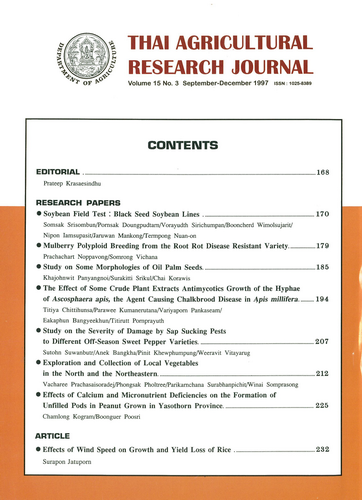Muulberry Polyploid Breeding from the Root Rot disease Resistant Variety
DOI:
https://doi.org/10.14456/thaidoa-agres.1997.17Abstract
The experiment was carried out during 1993-1995 at Sakon Nakhon Sericultural Experiment Station with an objective to design mulberry polyploid (tetraploid) from the root rot disease resistant variety for triploid mulberry breeding by using Kunpai variety. by taking 300 cuttings and divided into 6 groups, 50 cuttings per group, planted in sampling bags (one cutting per bag), treated with 0.4% colcichine solution by dropping the solution at the upmost bud of each cutting 2 times a day (early morining and late evening). The first group was treated by 0.4% colcichine solution for 1 days, the second group for 2 day (early morinng and late evening). The first group was treated by 0.4% colcichine solutio for 1 day, the seconds group for 2 days, the third group for 3 days, the forth group for 4 days, the fifth group for 5 days and the sixth group was dropped by distilled water for 5 days, the result showed that one month after colcichine treatment, there were 97 saplings showed tetraploid characters. However after 97 samplings traplanted into the field and the seletion was done by morphological charcters and chromosome counting by using leafiip. There were only three plants (two shoots per plants) showing tetraploid characters.
Downloads
Published
How to Cite
Issue
Section
License

This work is licensed under a Creative Commons Attribution-NonCommercial-NoDerivatives 4.0 International License.
Thai Agricultural Research Journal



